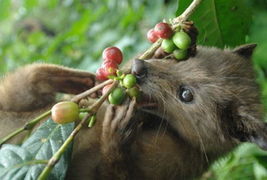The reason why Kopi Luwak is so expensive is the characteristics of Kopi Luwak
Coffee beans generally go through the process of fermentation of the shell. Coffee beans are in the intestinal tract of the civet. Special bacteria provide a unique fermentation environment. The flavor becomes unique and especially thick and mellow. Coffee beans fermented by civet intestines are especially thick and fragrant.
"Cat poop coffee" was once a tribute from Indonesia to the Dutch royal family. At that time, the industry regarded this coffee with the name "cat poop" as a joke, until National Geographic magazine carried a special report on this, everyone gradually became interested in this "cat poop coffee".

expensive
"Cat poop coffee" is the world's least produced coffee, a bag of 50 grams of coffee beans worth more than 800 yuan, only 4- 5 cups of coffee. In terms of conversion, a cup sells for about 200 yuan. Indonesia's largest coffee supplier, Fireboat Group, produces a small gift box of civet coffee for 600 yuan and 50 grams. The packaging is extremely luxurious, while the asking price of 100 grams is more than 2000 yuan. The annual output of wild coffee in the world does not exceed 400 kilograms. Villagers in these areas now collect not only wild ruaka waste but also caged ruaka. Large pots of picked coffee cherries were placed in front of Ruwaka, who was hungry and had no choice but to eat all the coffee cherries. The taste of the coffee produced in this way is naturally greatly discounted. "Rare is expensive", which has led to the high price of Kopi Luwak, a rare treasure. I'm afraid you can prepare 50 pounds for a cup of coffee, and you may not find it anywhere.
★ A cup of coffee made from 12 grams of cat feces coffee powder sponsored by Huochuan Group at the 2010 Shanghai World Expo is 380 yuan, and the daily limit of 12 cups is in short supply.
★ In Bali, a cup costs more than 200 thousand (more than 200,000) Indonesian rupiah, equivalent to more than RMB 150.
★ In the United States, 1 kg of cat poop coffee beans goes up to USD 1200. It is always around USD 1000 on the international market.
In the UK, a glass costs £ 50.
In Indonesian,"Kopi" means coffee, and "Luwak" is the Indonesian name for "civet." It is said that the annual production of this coffee does not exceed 500 pounds, and the price per pound ranges from $300 to $800, depending on the year, because there is no fixed production every year.
Luwak coffee remains a veritable luxury on the international market, not least because it is made not by humans but by wild animals. Traditionally, coffee fruit is washed or sun-dried to remove the peel, pulp and sheepskin layer, and finally the coffee beans are taken out, but Luwak coffee is made by natural fermentation in wild animals. Moreover, these wild animals are only found on small islands like Indonesia. The time and place of their appearance are mysterious, and their numbers are decreasing day by day. Indonesia has claimed that conservation and breeding have helped keep the civets stable, but the digestive system that created them to tempt human taste buds has nothing to do with industrial-age products.
"Civets" are omnivores. They are solitary and nocturnal. They inhabit tropical rain forests, subtropical evergreen broad-leaved forests, mountain shrubs or hills, mountains, grass and other places below 2000 meters above sea level. Its food includes small mammals, birds, amphibians and reptiles, crustaceans, insects and plant fruits, seeds and so on. "Civet" likes to choose the most ripe, sweet, full and juicy coffee fruit in the coffee tree as food, and the coffee fruit passes through its digestive system, only the pulp of the fruit is digested, and the hard coffee beans are then excreted intact by the "civet" digestive system. This is the "natural fermentation method" that was once scorned by Americans. It is said that when Americans heard that there was a way to make coffee in this way, they thought it was a fantasy until it was reported by National Geographic magazine.
The world's most luxurious coffee, the world's most expensive coffee, the world's rarest coffee…
Kopi Luwak has always been described like this, and it sounds like a boring anecdote.
It reminds me of Oscar Wilde.
People tend to pay too much attention to the price of things, and often ignore their own value…Forget the rumors of clumsy and useless embellishments,
Let's start a magical cat poop coffee tour...
unique flavor
Indonesian coffee has earthy and herbal flavours and the highest consistency of any continent. But "cat poop coffee" has a stronger earthy smell and a consistency closer to syrup, with a very special aroma. After drinking, there will still be a faint mint cool feeling in the mouth, which is the "exclusive taste" that ordinary coffee does not have. After drinking a cup, take a deep breath or take a mouthful of cold water, you can obviously feel a cool sensation from the mouth to the throat, as if you just ate a mint throat lozenge.
Experts say the Indonesian civet has a gland near its sex organs that secretes milky oil, which has long been a precious ingredient in perfume. Even Shakespeare's play King Lear has such a dialogue: "Please give me some civet oil to stimulate my inspiration." Another said: "This coffee is unique, it is a specialty of Indonesia. Drinking it is like finding a diamond in a stone." Because wild "civets" are obviously better at picking good coffee fruits, this coffee has a unique character.
Important Notice :
前街咖啡 FrontStreet Coffee has moved to new addredd:
FrontStreet Coffee Address: 315,Donghua East Road,GuangZhou
Tel:020 38364473
- Prev

Where was Kopi Luwak first introduced?
The company M.P. Mountanos, which first introduced Kopi Luwak coffee to the United States, pointed out that at first, when I heard about this kind of coffee fermented in the body, I thought it was a joke in the industry, but I didn't take it seriously. later, I saw a special report on Kopi Luwak in National Geographic Magazine and became interested in her. it took seven years to find a stable source of supply and began to introduce a small amount to the United States.
- Next

How the production of Kopi Luwak brews Kopi Luwak
The roasting process of Luwak coffee beans is as follows: 1, civets like to eat ripe red coffee fruits on coffee trees; 2, pick out undigested coffee seeds from cat droppings; 3, remove the silver gray film of coffee seeds, wash them in the sun and dry them in the sun; 4, stir-fry Luwak coffee beans. Production skills 1. After Indonesians remove the silver-gray film on the appearance of coffee beans, use water
Related
- Beginners will see the "Coffee pull flower" guide!
- What is the difference between ice blog purified milk and ordinary milk coffee?
- Why is the Philippines the largest producer of crops in Liberia?
- For coffee extraction, should the fine powder be retained?
- How does extracted espresso fill pressed powder? How much strength does it take to press the powder?
- How to make jasmine cold extract coffee? Is the jasmine + latte good?
- Will this little toy really make the coffee taste better? How does Lily Drip affect coffee extraction?
- Will the action of slapping the filter cup also affect coffee extraction?
- What's the difference between powder-to-water ratio and powder-to-liquid ratio?
- What is the Ethiopian local species? What does it have to do with Heirloom native species?

